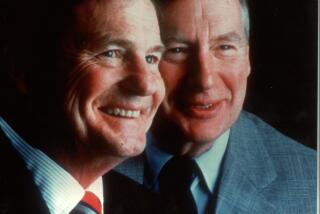Watergate: A Story to Sink Your Teeth Into
- Share via
Just came back from lunch. Frankly, it was a little dull. I ate in our cafeteria and had half a tuna sandwich, chips and a 20-ounce caffeinated beverage. The food was exquisitely prepared, but I ate in solitude and returned to my desk within 30 minutes. An exercise in rote, it was another lunch without a pulse.
It wasn’t always that way, a recollection brought back while browsing a press release on the 30th anniversary of Richard Nixon’s resignation of the presidency.
The folks at the Nixon Library & Birthplace in Yorba Linda put together a panel discussion Thursday to commemorate the event, but what the saga reminded me of was a series of weekday lunches that stretched from early 1973 (when the real Watergate conspiracy talk began) to Nixon’s resignation in August 1974.
If there was a more exciting time in American journalism -- whether you worked in the Beltway or the Farm Belt -- I don’t know when it would have been. For me and several of my twenty- and thirtysomething colleagues at the Omaha World-Herald, lunch revolved around this incredible story the Eastern press was chasing.
From the get-go, Watergate was pure Mystery Political Theater, featuring a cast of previously unknown political characters we came to know as well as those of any blockbuster TV series.
It started with a teaser -- a break-in at national Democratic Party headquarters in June 1972. Not a huge deal, but eventually, week by week, seemingly improbable scenarios emerged.
For us young Omaha journalists, Watergate was a five-martini lunch. We may have spent our mornings writing mundane accounts of school budgets or Midlands weather, but once we convened for lunch, Watergate promised conversation from Journalism Heaven. Instead of kvetching about tracking down details on local third-rate burglaries, we could dissect the effect of the president’s spokesman using the same term to describe Watergate.
Naturally, we immersed ourselves in the caper. If you didn’t know who Jeb Magruder was or couldn’t keep Haldeman and Ehrlichman straight, there was no need to join us at lunch. We didn’t have time to bring you up to speed.
Unlike our daily newspaper duties, the Watergate story kept getting better:
There’s no chance that the attorney general could have been involved.
Oh, no?
No way would Haldeman and Ehrlichman, Nixon’s top two aides, ever resign.
Wanna bet?
Do you really believe that this John Dean guy -- the president’s own lawyer -- was going to implicate the president?
Believe it.
For drama, the biggest moment for me was the so-called Saturday Night Massacre in October 1973, when Nixon wanted his new attorney general to fire the special Watergate prosecutor, but he wouldn’t do it. Instead, he resigned and so did his top deputy, who also wouldn’t carry out Nixon’s order. Nixon dipped into the ranks to find someone to fire Archibald Cox.
Suddenly, there was a chill in the air. If there was a scary Watergate moment, that was it.
We all know how things turned out. Watergate became part of American history, now discussed much more clinically than it was back then.
Other big “national conversation” stories have come along, such as the O.J. Simpson case and the Sept. 11 terrorist attacks. But those, like most big stories, came laden either with great sadness or anger or tragedy.
Watergate was different. It was a whodunit that we thought would never get solved but did. The story that couldn’t be true was true.
And for those many, many months in downtown Omaha, the best time of our lives was at lunch.
Dana Parsons can be reached at (714) 966-7821 or at dana.
parsons@latimes.com. An archive of his recent columns is at www.latimes.com/parsons.
More to Read
Get the L.A. Times Politics newsletter
Deeply reported insights into legislation, politics and policy from Sacramento, Washington and beyond. In your inbox twice per week.
You may occasionally receive promotional content from the Los Angeles Times.










